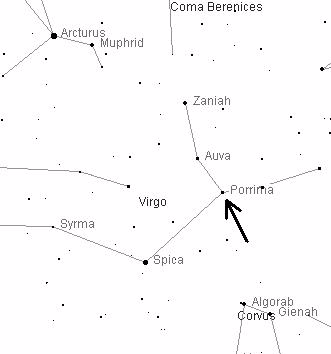Splitting Porrima
Jack Kramer
To me, double stars are interesting only if they're particularly colorful or if they're a challenge to split. Porrima (Gamma Virginis) falls in the latter category. It is two main sequence F0 class stars that lie about 32 light years away. They're presently about as far apart from each other as Uranus is from the sun, but the separation of the two stars changes over the years. It is now closing, and in 2007 will become impossible to see as a double in smaller telescopes. Gamma Virginis is on the Astronomical League's 100 doubles list, so unless the AL makes a change to the list, some people will be stuck at 99 doubles for awhile! But its orbit is fairly rapid and will begin to reopen quickly. It will then continue opening up for the next 85 years or so. According to Burnham's Celestial Handbook, the pair was too close to split in larger scopes for only a matter of months during its last periastron.

The orbit of the "B" star is almost comet-like. In fact, if we compare the Gamma Virginis system to our own Solar System, this star would enter the asteroid belt and then loop out almost twice as far as Neptune orbits around the sun.
This double star has been split cleanly with telescopes of about 3-inches aperture, but since high magnification is needed, the telescope optics must be very good. Obviously, atmospheric conditions have to be right too. On a night of good seeing in the spring of 2001, I tried it with my 4-inch refractor. (The smaller the telescope, the greater the challenge!) At about 200x, it appeared as an elongated star with two nodules - sort of a fat figure 8. At 245x, the figure 8 was more obvious, but still no split. Finally, at 330x in moments when the seeing improved, there appeared a faint black line between the two stars. To get to that magnification, I combined a 5mm Orthoscopic ocular with a 2x Barlow (this Barlow actually yielded a true 1.7x magnification factor). Note that this is over 80x per inch on the 4-inch scope...way beyond the maximum guideline of 50x per inch. But if the atmosphere is steady and your telescope has good optics, don't be afraid to push it for objects like bright double stars. Magnification is the key. On my 6-inch apochromatic refractor I also had to use 300x to split Porrima.
By the year 2015 or so, Porrima will again be one of the best double stars in the whole sky, still close but able to be split by most scopes.





